Business Resources and Financial Analysis of Tesco - Report
VerifiedAdded on 2020/06/06
|10
|2687
|46
Report
AI Summary
This report provides a detailed analysis of Tesco's business resources. It begins by examining the recruitment documentation used by Tesco, including the required soft and hard skills for various roles. The report then explores the physical and technological resources essential for Tesco's operations, emphasizing the importance of managing human, physical, and technological resources for organizational success. Furthermore, the report delves into the sources of internal and external finance available to Tesco, followed by an explanation of the components of a trading, profit and loss account, and balance sheet. The use of budgets for financial control is also discussed, along with an analysis of Tesco's financial state, including the application of ratio analysis to assess profitability and performance. The report concludes by highlighting the significance of effective resource management for business success.
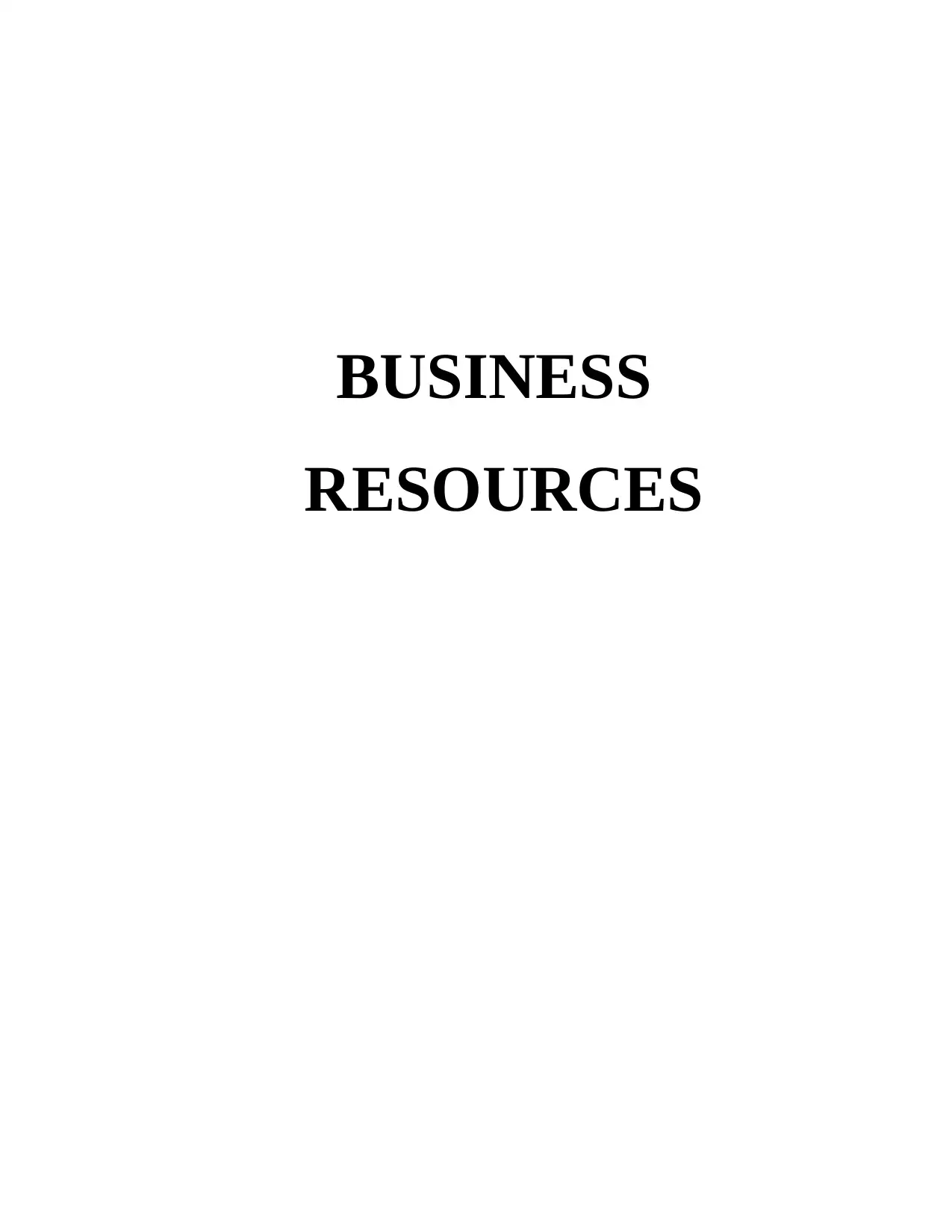
BUSINESS
RESOURCES
RESOURCES
Paraphrase This Document
Need a fresh take? Get an instant paraphrase of this document with our AI Paraphraser
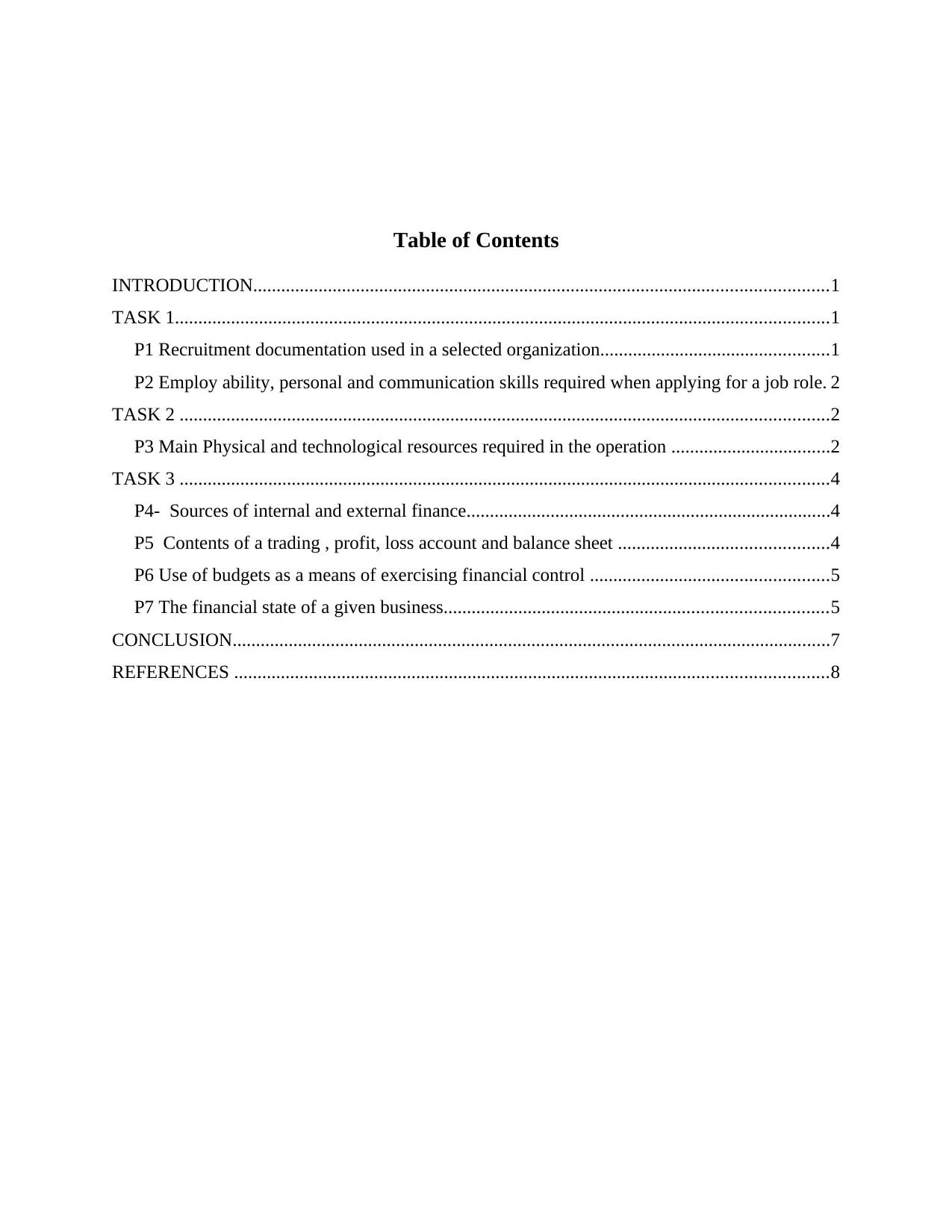
Table of Contents
INTRODUCTION...........................................................................................................................1
TASK 1............................................................................................................................................1
P1 Recruitment documentation used in a selected organization.................................................1
P2 Employ ability, personal and communication skills required when applying for a job role. 2
TASK 2 ...........................................................................................................................................2
P3 Main Physical and technological resources required in the operation ..................................2
TASK 3 ...........................................................................................................................................4
P4- Sources of internal and external finance..............................................................................4
P5 Contents of a trading , profit, loss account and balance sheet .............................................4
P6 Use of budgets as a means of exercising financial control ...................................................5
P7 The financial state of a given business..................................................................................5
CONCLUSION................................................................................................................................7
REFERENCES ...............................................................................................................................8
INTRODUCTION...........................................................................................................................1
TASK 1............................................................................................................................................1
P1 Recruitment documentation used in a selected organization.................................................1
P2 Employ ability, personal and communication skills required when applying for a job role. 2
TASK 2 ...........................................................................................................................................2
P3 Main Physical and technological resources required in the operation ..................................2
TASK 3 ...........................................................................................................................................4
P4- Sources of internal and external finance..............................................................................4
P5 Contents of a trading , profit, loss account and balance sheet .............................................4
P6 Use of budgets as a means of exercising financial control ...................................................5
P7 The financial state of a given business..................................................................................5
CONCLUSION................................................................................................................................7
REFERENCES ...............................................................................................................................8
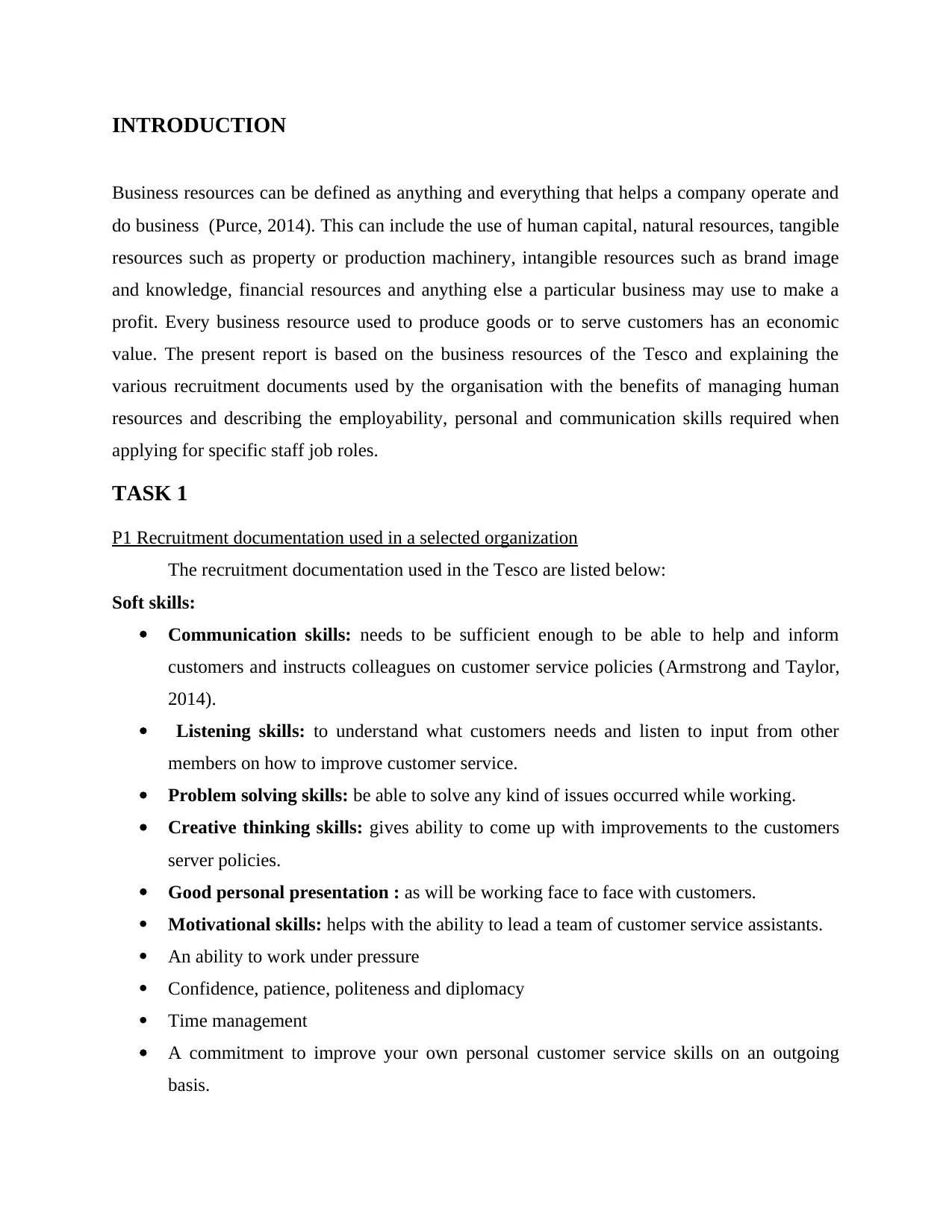
INTRODUCTION
Business resources can be defined as anything and everything that helps a company operate and
do business (Purce, 2014). This can include the use of human capital, natural resources, tangible
resources such as property or production machinery, intangible resources such as brand image
and knowledge, financial resources and anything else a particular business may use to make a
profit. Every business resource used to produce goods or to serve customers has an economic
value. The present report is based on the business resources of the Tesco and explaining the
various recruitment documents used by the organisation with the benefits of managing human
resources and describing the employability, personal and communication skills required when
applying for specific staff job roles.
TASK 1
P1 Recruitment documentation used in a selected organization
The recruitment documentation used in the Tesco are listed below:
Soft skills:
Communication skills: needs to be sufficient enough to be able to help and inform
customers and instructs colleagues on customer service policies (Armstrong and Taylor,
2014).
Listening skills: to understand what customers needs and listen to input from other
members on how to improve customer service.
Problem solving skills: be able to solve any kind of issues occurred while working.
Creative thinking skills: gives ability to come up with improvements to the customers
server policies.
Good personal presentation : as will be working face to face with customers.
Motivational skills: helps with the ability to lead a team of customer service assistants.
An ability to work under pressure
Confidence, patience, politeness and diplomacy
Time management
A commitment to improve your own personal customer service skills on an outgoing
basis.
Business resources can be defined as anything and everything that helps a company operate and
do business (Purce, 2014). This can include the use of human capital, natural resources, tangible
resources such as property or production machinery, intangible resources such as brand image
and knowledge, financial resources and anything else a particular business may use to make a
profit. Every business resource used to produce goods or to serve customers has an economic
value. The present report is based on the business resources of the Tesco and explaining the
various recruitment documents used by the organisation with the benefits of managing human
resources and describing the employability, personal and communication skills required when
applying for specific staff job roles.
TASK 1
P1 Recruitment documentation used in a selected organization
The recruitment documentation used in the Tesco are listed below:
Soft skills:
Communication skills: needs to be sufficient enough to be able to help and inform
customers and instructs colleagues on customer service policies (Armstrong and Taylor,
2014).
Listening skills: to understand what customers needs and listen to input from other
members on how to improve customer service.
Problem solving skills: be able to solve any kind of issues occurred while working.
Creative thinking skills: gives ability to come up with improvements to the customers
server policies.
Good personal presentation : as will be working face to face with customers.
Motivational skills: helps with the ability to lead a team of customer service assistants.
An ability to work under pressure
Confidence, patience, politeness and diplomacy
Time management
A commitment to improve your own personal customer service skills on an outgoing
basis.
⊘ This is a preview!⊘
Do you want full access?
Subscribe today to unlock all pages.

Trusted by 1+ million students worldwide
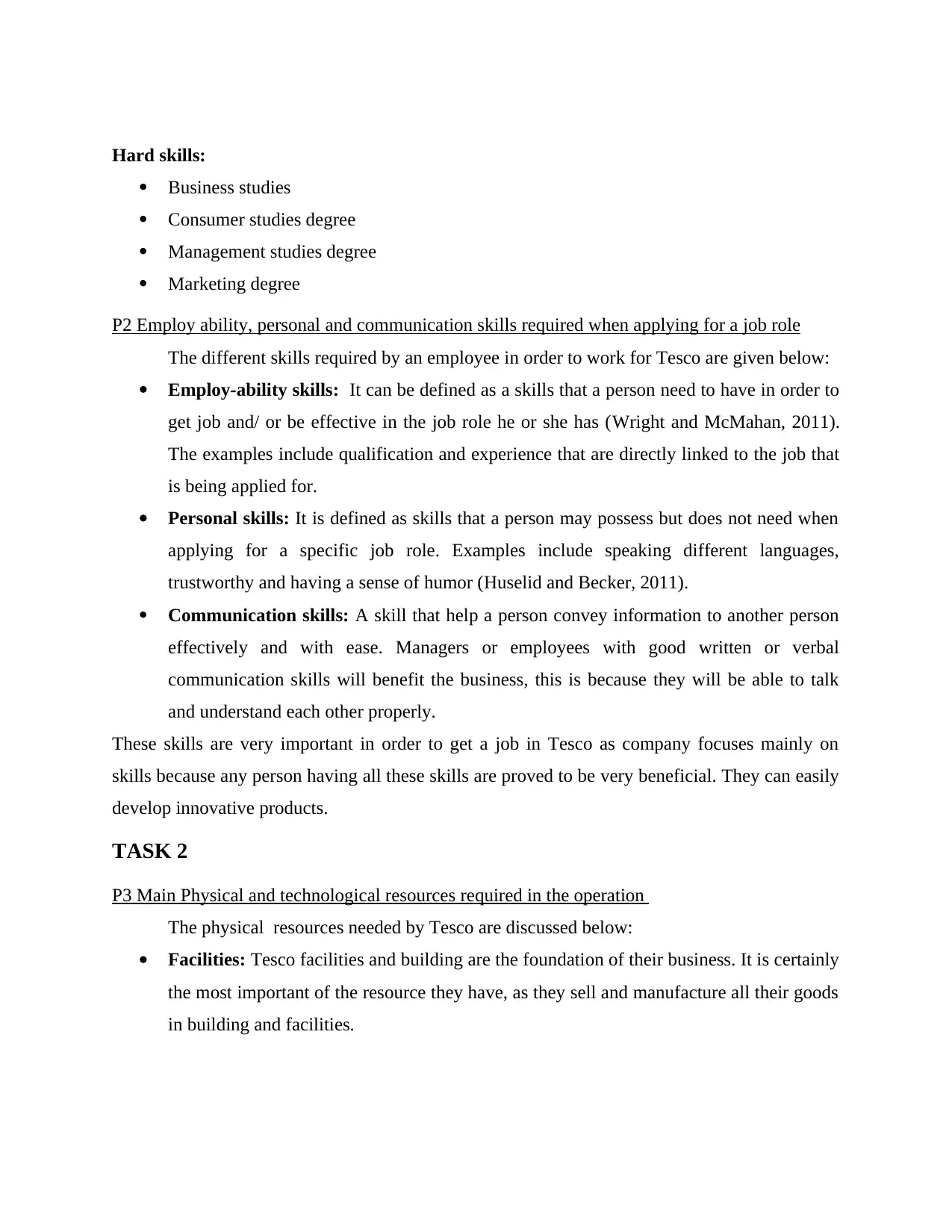
Hard skills:
Business studies
Consumer studies degree
Management studies degree
Marketing degree
P2 Employ ability, personal and communication skills required when applying for a job role
The different skills required by an employee in order to work for Tesco are given below:
Employ-ability skills: It can be defined as a skills that a person need to have in order to
get job and/ or be effective in the job role he or she has (Wright and McMahan, 2011).
The examples include qualification and experience that are directly linked to the job that
is being applied for.
Personal skills: It is defined as skills that a person may possess but does not need when
applying for a specific job role. Examples include speaking different languages,
trustworthy and having a sense of humor (Huselid and Becker, 2011).
Communication skills: A skill that help a person convey information to another person
effectively and with ease. Managers or employees with good written or verbal
communication skills will benefit the business, this is because they will be able to talk
and understand each other properly.
These skills are very important in order to get a job in Tesco as company focuses mainly on
skills because any person having all these skills are proved to be very beneficial. They can easily
develop innovative products.
TASK 2
P3 Main Physical and technological resources required in the operation
The physical resources needed by Tesco are discussed below:
Facilities: Tesco facilities and building are the foundation of their business. It is certainly
the most important of the resource they have, as they sell and manufacture all their goods
in building and facilities.
Business studies
Consumer studies degree
Management studies degree
Marketing degree
P2 Employ ability, personal and communication skills required when applying for a job role
The different skills required by an employee in order to work for Tesco are given below:
Employ-ability skills: It can be defined as a skills that a person need to have in order to
get job and/ or be effective in the job role he or she has (Wright and McMahan, 2011).
The examples include qualification and experience that are directly linked to the job that
is being applied for.
Personal skills: It is defined as skills that a person may possess but does not need when
applying for a specific job role. Examples include speaking different languages,
trustworthy and having a sense of humor (Huselid and Becker, 2011).
Communication skills: A skill that help a person convey information to another person
effectively and with ease. Managers or employees with good written or verbal
communication skills will benefit the business, this is because they will be able to talk
and understand each other properly.
These skills are very important in order to get a job in Tesco as company focuses mainly on
skills because any person having all these skills are proved to be very beneficial. They can easily
develop innovative products.
TASK 2
P3 Main Physical and technological resources required in the operation
The physical resources needed by Tesco are discussed below:
Facilities: Tesco facilities and building are the foundation of their business. It is certainly
the most important of the resource they have, as they sell and manufacture all their goods
in building and facilities.
Paraphrase This Document
Need a fresh take? Get an instant paraphrase of this document with our AI Paraphraser
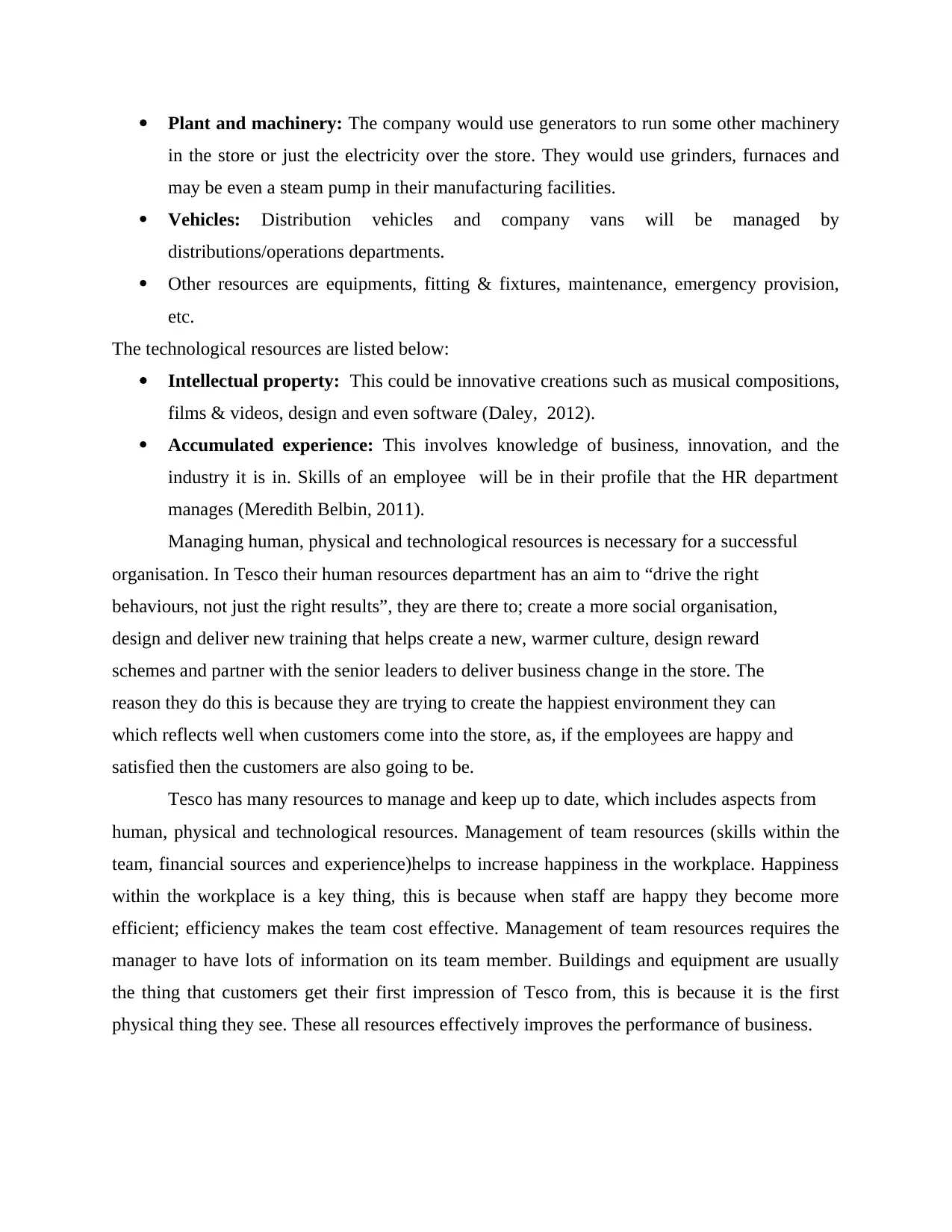
Plant and machinery: The company would use generators to run some other machinery
in the store or just the electricity over the store. They would use grinders, furnaces and
may be even a steam pump in their manufacturing facilities.
Vehicles: Distribution vehicles and company vans will be managed by
distributions/operations departments.
Other resources are equipments, fitting & fixtures, maintenance, emergency provision,
etc.
The technological resources are listed below:
Intellectual property: This could be innovative creations such as musical compositions,
films & videos, design and even software (Daley, 2012).
Accumulated experience: This involves knowledge of business, innovation, and the
industry it is in. Skills of an employee will be in their profile that the HR department
manages (Meredith Belbin, 2011).
Managing human, physical and technological resources is necessary for a successful
organisation. In Tesco their human resources department has an aim to “drive the right
behaviours, not just the right results”, they are there to; create a more social organisation,
design and deliver new training that helps create a new, warmer culture, design reward
schemes and partner with the senior leaders to deliver business change in the store. The
reason they do this is because they are trying to create the happiest environment they can
which reflects well when customers come into the store, as, if the employees are happy and
satisfied then the customers are also going to be.
Tesco has many resources to manage and keep up to date, which includes aspects from
human, physical and technological resources. Management of team resources (skills within the
team, financial sources and experience)helps to increase happiness in the workplace. Happiness
within the workplace is a key thing, this is because when staff are happy they become more
efficient; efficiency makes the team cost effective. Management of team resources requires the
manager to have lots of information on its team member. Buildings and equipment are usually
the thing that customers get their first impression of Tesco from, this is because it is the first
physical thing they see. These all resources effectively improves the performance of business.
in the store or just the electricity over the store. They would use grinders, furnaces and
may be even a steam pump in their manufacturing facilities.
Vehicles: Distribution vehicles and company vans will be managed by
distributions/operations departments.
Other resources are equipments, fitting & fixtures, maintenance, emergency provision,
etc.
The technological resources are listed below:
Intellectual property: This could be innovative creations such as musical compositions,
films & videos, design and even software (Daley, 2012).
Accumulated experience: This involves knowledge of business, innovation, and the
industry it is in. Skills of an employee will be in their profile that the HR department
manages (Meredith Belbin, 2011).
Managing human, physical and technological resources is necessary for a successful
organisation. In Tesco their human resources department has an aim to “drive the right
behaviours, not just the right results”, they are there to; create a more social organisation,
design and deliver new training that helps create a new, warmer culture, design reward
schemes and partner with the senior leaders to deliver business change in the store. The
reason they do this is because they are trying to create the happiest environment they can
which reflects well when customers come into the store, as, if the employees are happy and
satisfied then the customers are also going to be.
Tesco has many resources to manage and keep up to date, which includes aspects from
human, physical and technological resources. Management of team resources (skills within the
team, financial sources and experience)helps to increase happiness in the workplace. Happiness
within the workplace is a key thing, this is because when staff are happy they become more
efficient; efficiency makes the team cost effective. Management of team resources requires the
manager to have lots of information on its team member. Buildings and equipment are usually
the thing that customers get their first impression of Tesco from, this is because it is the first
physical thing they see. These all resources effectively improves the performance of business.
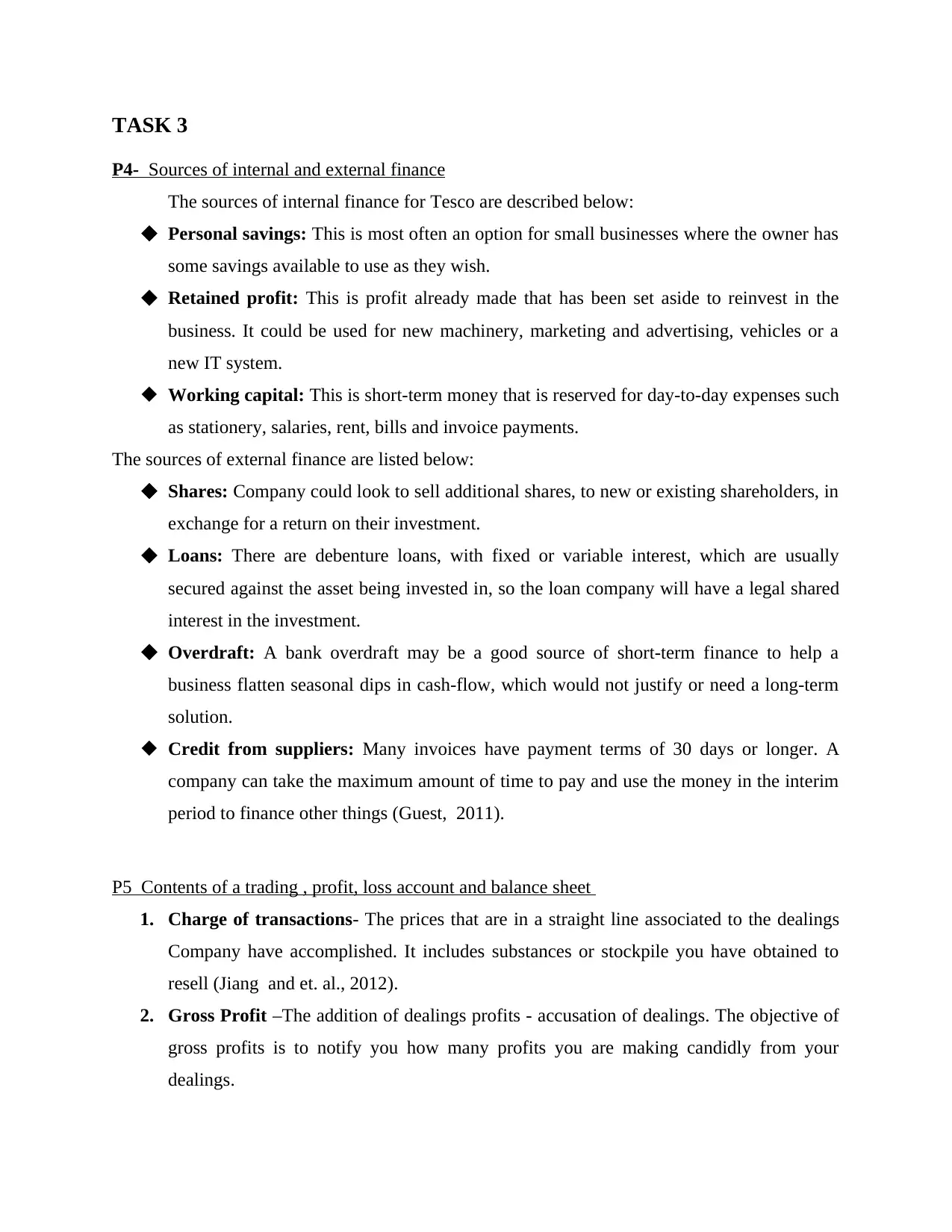
TASK 3
P4- Sources of internal and external finance
The sources of internal finance for Tesco are described below:
Personal savings: This is most often an option for small businesses where the owner has
some savings available to use as they wish.
Retained profit: This is profit already made that has been set aside to reinvest in the
business. It could be used for new machinery, marketing and advertising, vehicles or a
new IT system.
Working capital: This is short-term money that is reserved for day-to-day expenses such
as stationery, salaries, rent, bills and invoice payments.
The sources of external finance are listed below:
Shares: Company could look to sell additional shares, to new or existing shareholders, in
exchange for a return on their investment.
Loans: There are debenture loans, with fixed or variable interest, which are usually
secured against the asset being invested in, so the loan company will have a legal shared
interest in the investment.
Overdraft: A bank overdraft may be a good source of short-term finance to help a
business flatten seasonal dips in cash-flow, which would not justify or need a long-term
solution.
Credit from suppliers: Many invoices have payment terms of 30 days or longer. A
company can take the maximum amount of time to pay and use the money in the interim
period to finance other things (Guest, 2011).
P5 Contents of a trading , profit, loss account and balance sheet
1. Charge of transactions- The prices that are in a straight line associated to the dealings
Company have accomplished. It includes substances or stockpile you have obtained to
resell (Jiang and et. al., 2012).
2. Gross Profit –The addition of dealings profits - accusation of dealings. The objective of
gross profits is to notify you how many profits you are making candidly from your
dealings.
P4- Sources of internal and external finance
The sources of internal finance for Tesco are described below:
Personal savings: This is most often an option for small businesses where the owner has
some savings available to use as they wish.
Retained profit: This is profit already made that has been set aside to reinvest in the
business. It could be used for new machinery, marketing and advertising, vehicles or a
new IT system.
Working capital: This is short-term money that is reserved for day-to-day expenses such
as stationery, salaries, rent, bills and invoice payments.
The sources of external finance are listed below:
Shares: Company could look to sell additional shares, to new or existing shareholders, in
exchange for a return on their investment.
Loans: There are debenture loans, with fixed or variable interest, which are usually
secured against the asset being invested in, so the loan company will have a legal shared
interest in the investment.
Overdraft: A bank overdraft may be a good source of short-term finance to help a
business flatten seasonal dips in cash-flow, which would not justify or need a long-term
solution.
Credit from suppliers: Many invoices have payment terms of 30 days or longer. A
company can take the maximum amount of time to pay and use the money in the interim
period to finance other things (Guest, 2011).
P5 Contents of a trading , profit, loss account and balance sheet
1. Charge of transactions- The prices that are in a straight line associated to the dealings
Company have accomplished. It includes substances or stockpile you have obtained to
resell (Jiang and et. al., 2012).
2. Gross Profit –The addition of dealings profits - accusation of dealings. The objective of
gross profits is to notify you how many profits you are making candidly from your
dealings.
⊘ This is a preview!⊘
Do you want full access?
Subscribe today to unlock all pages.

Trusted by 1+ million students worldwide
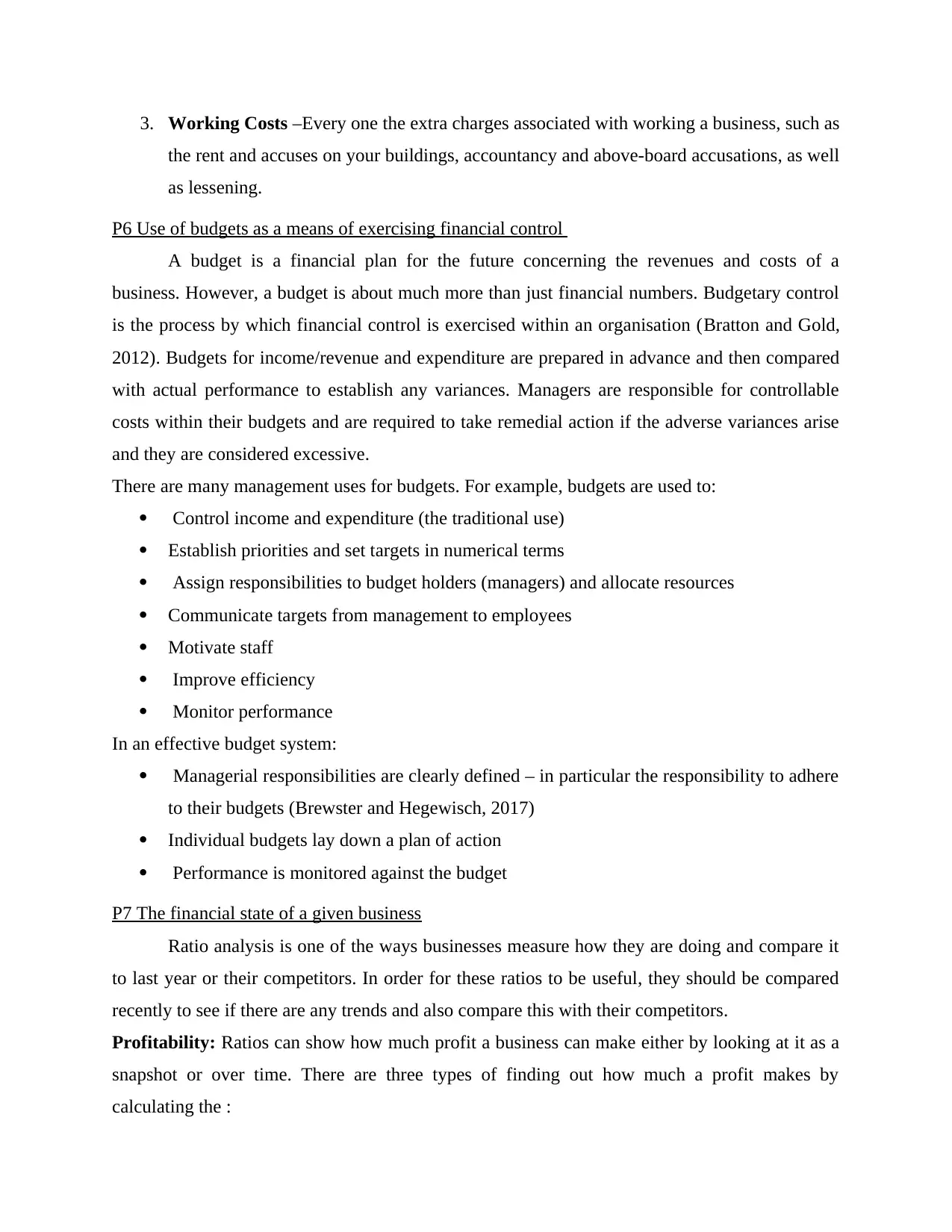
3. Working Costs –Every one the extra charges associated with working a business, such as
the rent and accuses on your buildings, accountancy and above-board accusations, as well
as lessening.
P6 Use of budgets as a means of exercising financial control
A budget is a financial plan for the future concerning the revenues and costs of a
business. However, a budget is about much more than just financial numbers. Budgetary control
is the process by which financial control is exercised within an organisation (Bratton and Gold,
2012). Budgets for income/revenue and expenditure are prepared in advance and then compared
with actual performance to establish any variances. Managers are responsible for controllable
costs within their budgets and are required to take remedial action if the adverse variances arise
and they are considered excessive.
There are many management uses for budgets. For example, budgets are used to:
Control income and expenditure (the traditional use)
Establish priorities and set targets in numerical terms
Assign responsibilities to budget holders (managers) and allocate resources
Communicate targets from management to employees
Motivate staff
Improve efficiency
Monitor performance
In an effective budget system:
Managerial responsibilities are clearly defined – in particular the responsibility to adhere
to their budgets (Brewster and Hegewisch, 2017)
Individual budgets lay down a plan of action
Performance is monitored against the budget
P7 The financial state of a given business
Ratio analysis is one of the ways businesses measure how they are doing and compare it
to last year or their competitors. In order for these ratios to be useful, they should be compared
recently to see if there are any trends and also compare this with their competitors.
Profitability: Ratios can show how much profit a business can make either by looking at it as a
snapshot or over time. There are three types of finding out how much a profit makes by
calculating the :
the rent and accuses on your buildings, accountancy and above-board accusations, as well
as lessening.
P6 Use of budgets as a means of exercising financial control
A budget is a financial plan for the future concerning the revenues and costs of a
business. However, a budget is about much more than just financial numbers. Budgetary control
is the process by which financial control is exercised within an organisation (Bratton and Gold,
2012). Budgets for income/revenue and expenditure are prepared in advance and then compared
with actual performance to establish any variances. Managers are responsible for controllable
costs within their budgets and are required to take remedial action if the adverse variances arise
and they are considered excessive.
There are many management uses for budgets. For example, budgets are used to:
Control income and expenditure (the traditional use)
Establish priorities and set targets in numerical terms
Assign responsibilities to budget holders (managers) and allocate resources
Communicate targets from management to employees
Motivate staff
Improve efficiency
Monitor performance
In an effective budget system:
Managerial responsibilities are clearly defined – in particular the responsibility to adhere
to their budgets (Brewster and Hegewisch, 2017)
Individual budgets lay down a plan of action
Performance is monitored against the budget
P7 The financial state of a given business
Ratio analysis is one of the ways businesses measure how they are doing and compare it
to last year or their competitors. In order for these ratios to be useful, they should be compared
recently to see if there are any trends and also compare this with their competitors.
Profitability: Ratios can show how much profit a business can make either by looking at it as a
snapshot or over time. There are three types of finding out how much a profit makes by
calculating the :
Paraphrase This Document
Need a fresh take? Get an instant paraphrase of this document with our AI Paraphraser
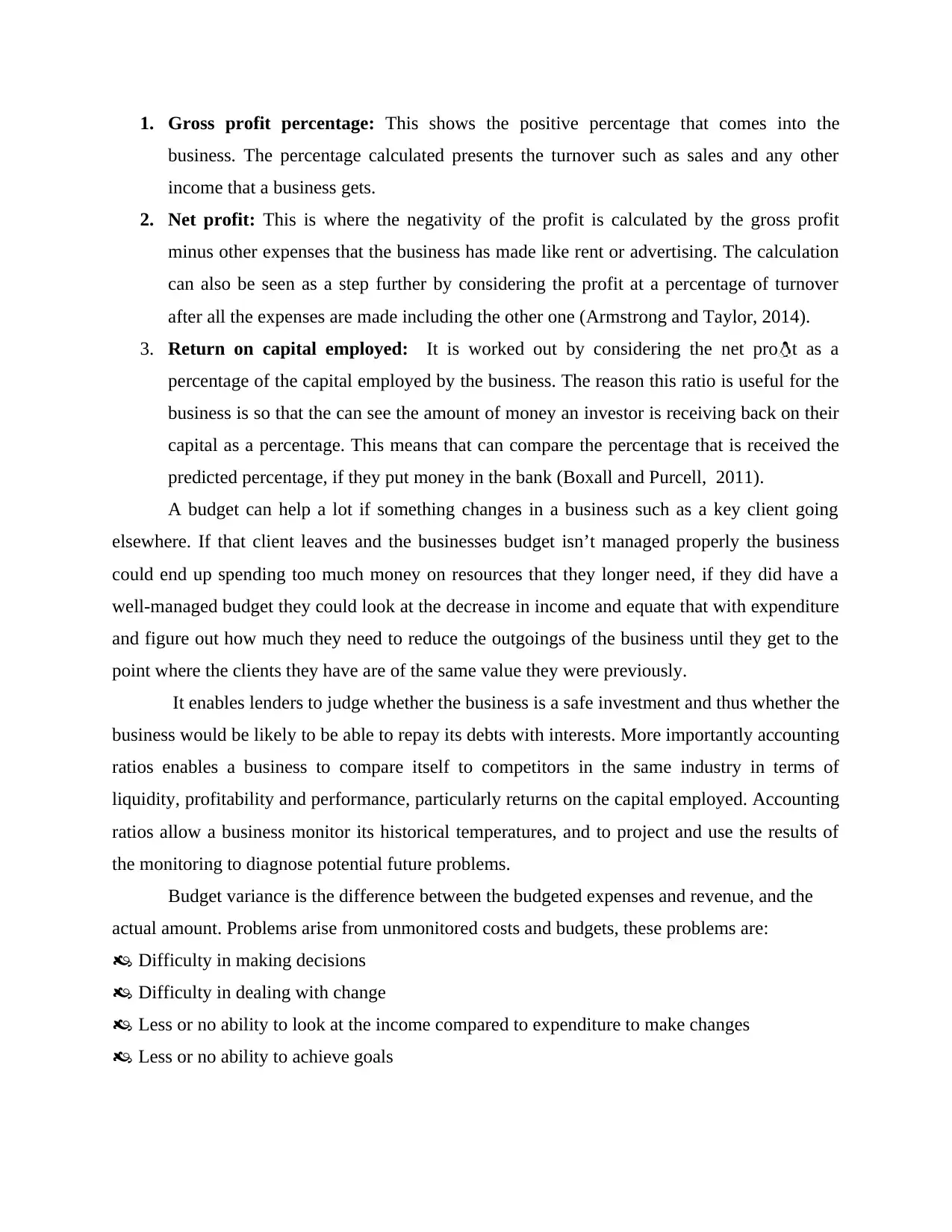
1. Gross profit percentage: This shows the positive percentage that comes into the
business. The percentage calculated presents the turnover such as sales and any other
income that a business gets.
2. Net profit: This is where the negativity of the profit is calculated by the gross profit
minus other expenses that the business has made like rent or advertising. The calculation
can also be seen as a step further by considering the profit at a percentage of turnover
after all the expenses are made including the other one (Armstrong and Taylor, 2014).
3. Return on capital employed: It is worked out by considering the net pro t as a
percentage of the capital employed by the business. The reason this ratio is useful for the
business is so that the can see the amount of money an investor is receiving back on their
capital as a percentage. This means that can compare the percentage that is received the
predicted percentage, if they put money in the bank (Boxall and Purcell, 2011).
A budget can help a lot if something changes in a business such as a key client going
elsewhere. If that client leaves and the businesses budget isn’t managed properly the business
could end up spending too much money on resources that they longer need, if they did have a
well-managed budget they could look at the decrease in income and equate that with expenditure
and figure out how much they need to reduce the outgoings of the business until they get to the
point where the clients they have are of the same value they were previously.
It enables lenders to judge whether the business is a safe investment and thus whether the
business would be likely to be able to repay its debts with interests. More importantly accounting
ratios enables a business to compare itself to competitors in the same industry in terms of
liquidity, profitability and performance, particularly returns on the capital employed. Accounting
ratios allow a business monitor its historical temperatures, and to project and use the results of
the monitoring to diagnose potential future problems.
Budget variance is the difference between the budgeted expenses and revenue, and the
actual amount. Problems arise from unmonitored costs and budgets, these problems are:
Difficulty in making decisions
Difficulty in dealing with change
Less or no ability to look at the income compared to expenditure to make changes
Less or no ability to achieve goals
business. The percentage calculated presents the turnover such as sales and any other
income that a business gets.
2. Net profit: This is where the negativity of the profit is calculated by the gross profit
minus other expenses that the business has made like rent or advertising. The calculation
can also be seen as a step further by considering the profit at a percentage of turnover
after all the expenses are made including the other one (Armstrong and Taylor, 2014).
3. Return on capital employed: It is worked out by considering the net pro t as a
percentage of the capital employed by the business. The reason this ratio is useful for the
business is so that the can see the amount of money an investor is receiving back on their
capital as a percentage. This means that can compare the percentage that is received the
predicted percentage, if they put money in the bank (Boxall and Purcell, 2011).
A budget can help a lot if something changes in a business such as a key client going
elsewhere. If that client leaves and the businesses budget isn’t managed properly the business
could end up spending too much money on resources that they longer need, if they did have a
well-managed budget they could look at the decrease in income and equate that with expenditure
and figure out how much they need to reduce the outgoings of the business until they get to the
point where the clients they have are of the same value they were previously.
It enables lenders to judge whether the business is a safe investment and thus whether the
business would be likely to be able to repay its debts with interests. More importantly accounting
ratios enables a business to compare itself to competitors in the same industry in terms of
liquidity, profitability and performance, particularly returns on the capital employed. Accounting
ratios allow a business monitor its historical temperatures, and to project and use the results of
the monitoring to diagnose potential future problems.
Budget variance is the difference between the budgeted expenses and revenue, and the
actual amount. Problems arise from unmonitored costs and budgets, these problems are:
Difficulty in making decisions
Difficulty in dealing with change
Less or no ability to look at the income compared to expenditure to make changes
Less or no ability to achieve goals
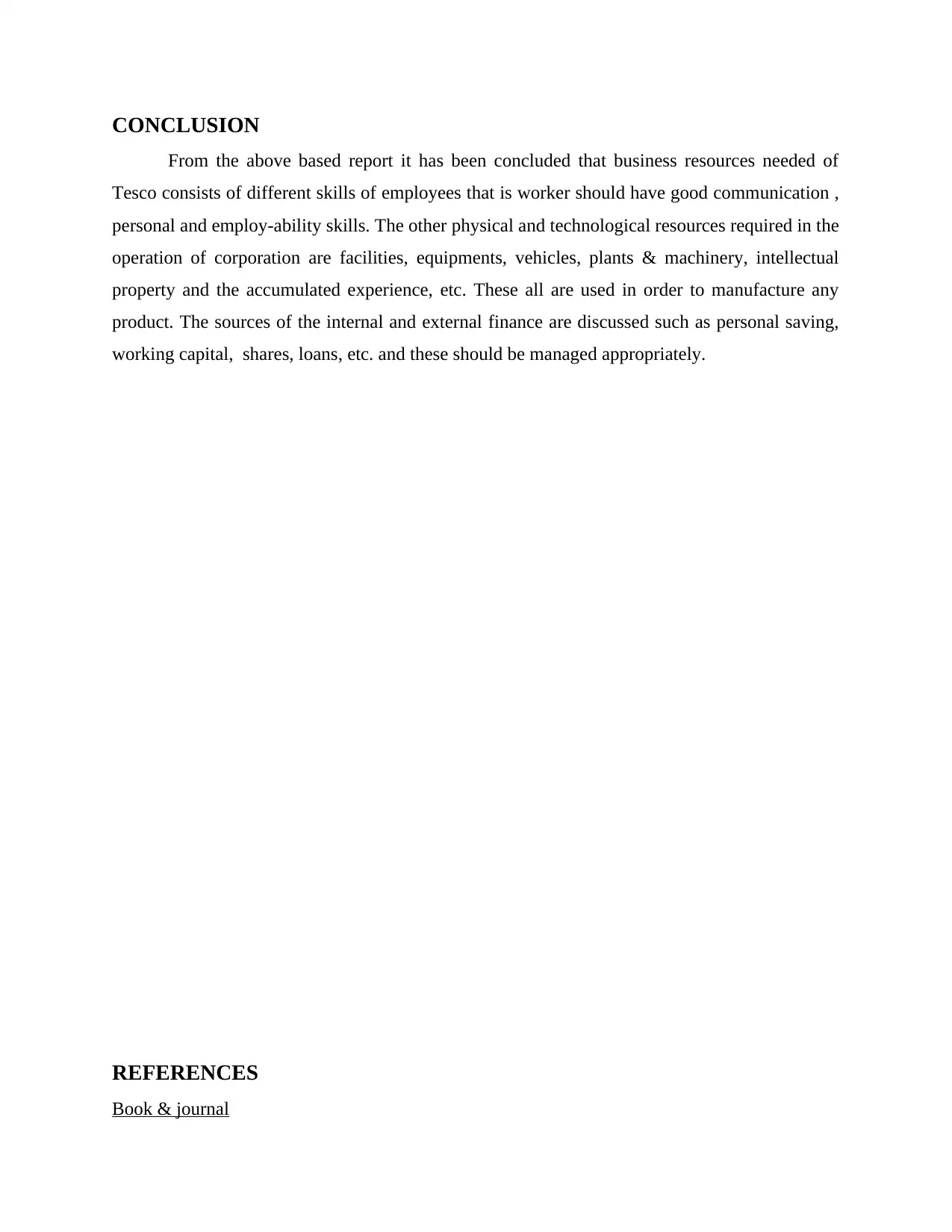
CONCLUSION
From the above based report it has been concluded that business resources needed of
Tesco consists of different skills of employees that is worker should have good communication ,
personal and employ-ability skills. The other physical and technological resources required in the
operation of corporation are facilities, equipments, vehicles, plants & machinery, intellectual
property and the accumulated experience, etc. These all are used in order to manufacture any
product. The sources of the internal and external finance are discussed such as personal saving,
working capital, shares, loans, etc. and these should be managed appropriately.
REFERENCES
Book & journal
From the above based report it has been concluded that business resources needed of
Tesco consists of different skills of employees that is worker should have good communication ,
personal and employ-ability skills. The other physical and technological resources required in the
operation of corporation are facilities, equipments, vehicles, plants & machinery, intellectual
property and the accumulated experience, etc. These all are used in order to manufacture any
product. The sources of the internal and external finance are discussed such as personal saving,
working capital, shares, loans, etc. and these should be managed appropriately.
REFERENCES
Book & journal
⊘ This is a preview!⊘
Do you want full access?
Subscribe today to unlock all pages.

Trusted by 1+ million students worldwide
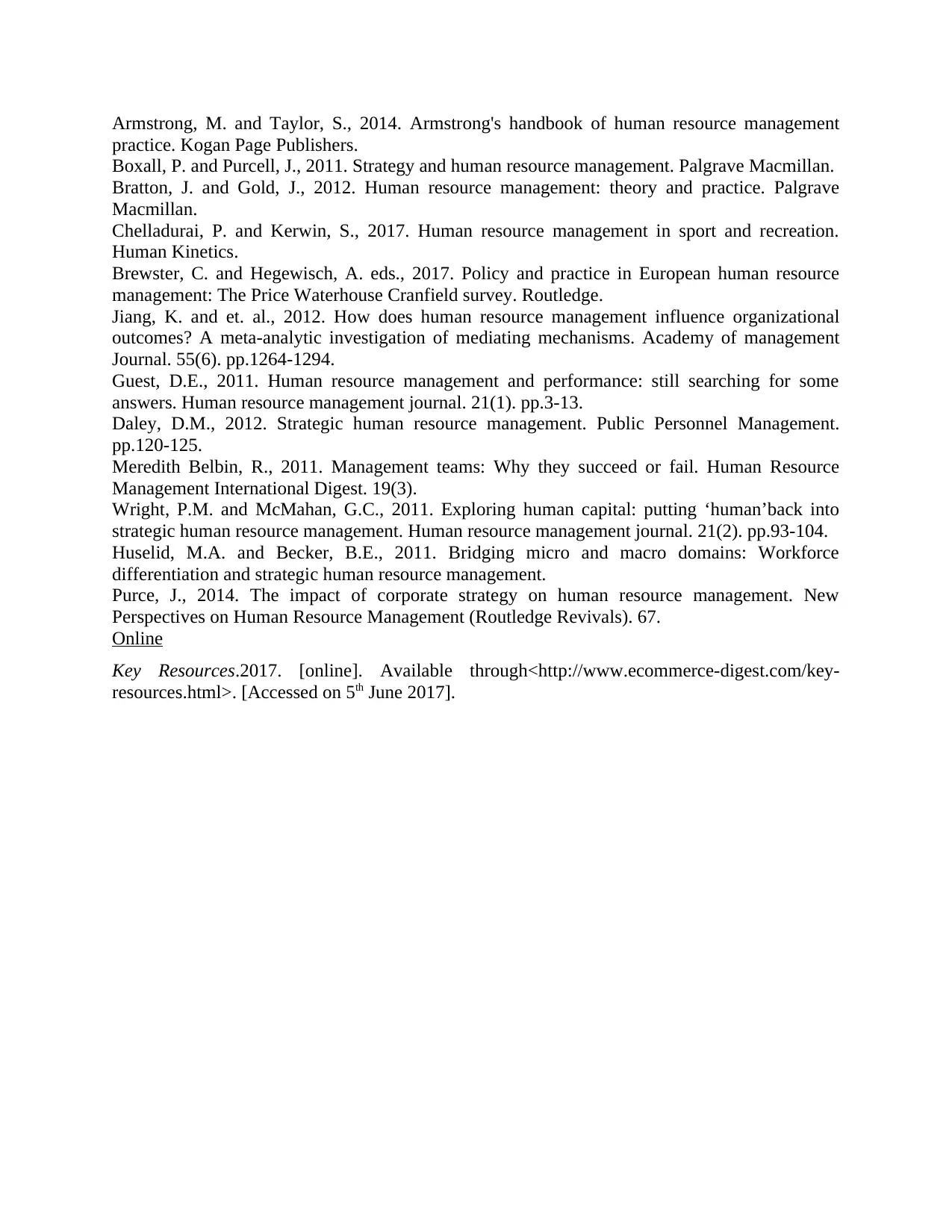
Armstrong, M. and Taylor, S., 2014. Armstrong's handbook of human resource management
practice. Kogan Page Publishers.
Boxall, P. and Purcell, J., 2011. Strategy and human resource management. Palgrave Macmillan.
Bratton, J. and Gold, J., 2012. Human resource management: theory and practice. Palgrave
Macmillan.
Chelladurai, P. and Kerwin, S., 2017. Human resource management in sport and recreation.
Human Kinetics.
Brewster, C. and Hegewisch, A. eds., 2017. Policy and practice in European human resource
management: The Price Waterhouse Cranfield survey. Routledge.
Jiang, K. and et. al., 2012. How does human resource management influence organizational
outcomes? A meta-analytic investigation of mediating mechanisms. Academy of management
Journal. 55(6). pp.1264-1294.
Guest, D.E., 2011. Human resource management and performance: still searching for some
answers. Human resource management journal. 21(1). pp.3-13.
Daley, D.M., 2012. Strategic human resource management. Public Personnel Management.
pp.120-125.
Meredith Belbin, R., 2011. Management teams: Why they succeed or fail. Human Resource
Management International Digest. 19(3).
Wright, P.M. and McMahan, G.C., 2011. Exploring human capital: putting ‘human’back into
strategic human resource management. Human resource management journal. 21(2). pp.93-104.
Huselid, M.A. and Becker, B.E., 2011. Bridging micro and macro domains: Workforce
differentiation and strategic human resource management.
Purce, J., 2014. The impact of corporate strategy on human resource management. New
Perspectives on Human Resource Management (Routledge Revivals). 67.
Online
Key Resources.2017. [online]. Available through<http://www.ecommerce-digest.com/key-
resources.html>. [Accessed on 5th June 2017].
practice. Kogan Page Publishers.
Boxall, P. and Purcell, J., 2011. Strategy and human resource management. Palgrave Macmillan.
Bratton, J. and Gold, J., 2012. Human resource management: theory and practice. Palgrave
Macmillan.
Chelladurai, P. and Kerwin, S., 2017. Human resource management in sport and recreation.
Human Kinetics.
Brewster, C. and Hegewisch, A. eds., 2017. Policy and practice in European human resource
management: The Price Waterhouse Cranfield survey. Routledge.
Jiang, K. and et. al., 2012. How does human resource management influence organizational
outcomes? A meta-analytic investigation of mediating mechanisms. Academy of management
Journal. 55(6). pp.1264-1294.
Guest, D.E., 2011. Human resource management and performance: still searching for some
answers. Human resource management journal. 21(1). pp.3-13.
Daley, D.M., 2012. Strategic human resource management. Public Personnel Management.
pp.120-125.
Meredith Belbin, R., 2011. Management teams: Why they succeed or fail. Human Resource
Management International Digest. 19(3).
Wright, P.M. and McMahan, G.C., 2011. Exploring human capital: putting ‘human’back into
strategic human resource management. Human resource management journal. 21(2). pp.93-104.
Huselid, M.A. and Becker, B.E., 2011. Bridging micro and macro domains: Workforce
differentiation and strategic human resource management.
Purce, J., 2014. The impact of corporate strategy on human resource management. New
Perspectives on Human Resource Management (Routledge Revivals). 67.
Online
Key Resources.2017. [online]. Available through<http://www.ecommerce-digest.com/key-
resources.html>. [Accessed on 5th June 2017].
1 out of 10
Related Documents
Your All-in-One AI-Powered Toolkit for Academic Success.
+13062052269
info@desklib.com
Available 24*7 on WhatsApp / Email
![[object Object]](/_next/static/media/star-bottom.7253800d.svg)
Unlock your academic potential
Copyright © 2020–2025 A2Z Services. All Rights Reserved. Developed and managed by ZUCOL.





